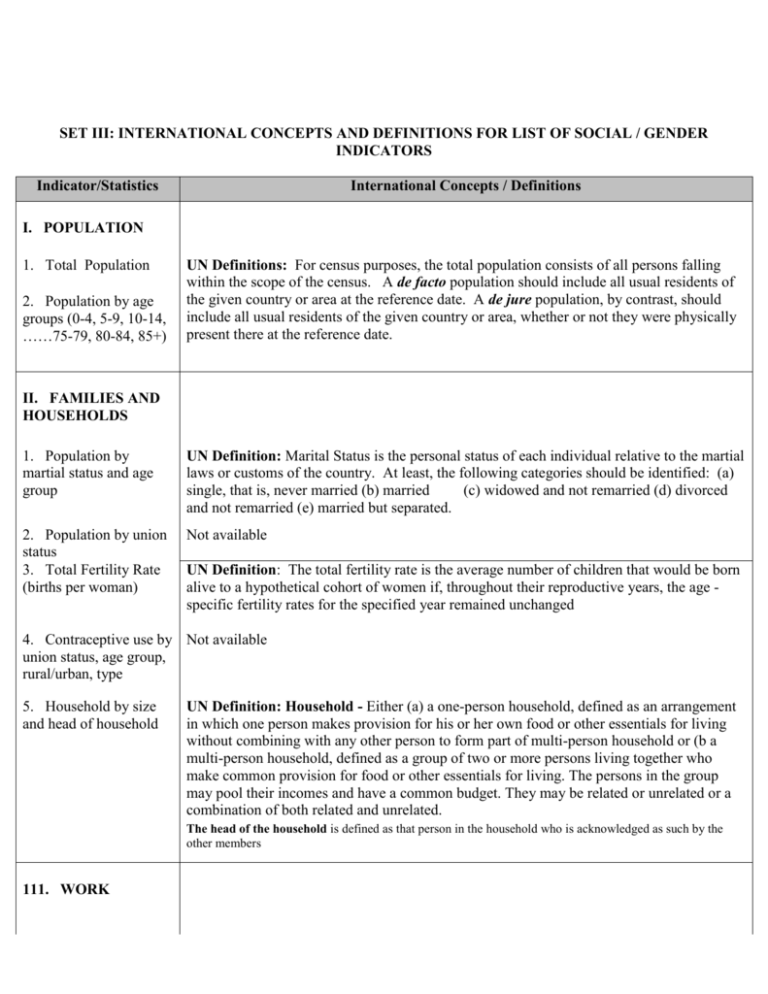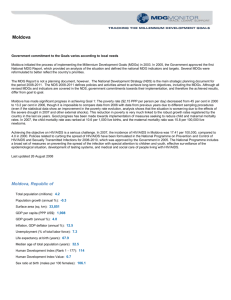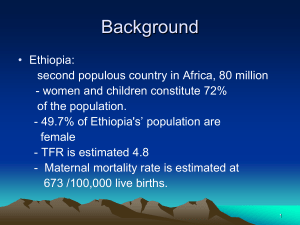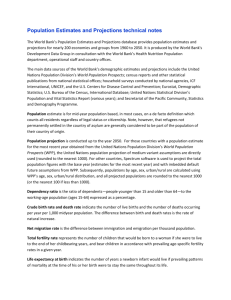SET III-International ConceptsDefinitions
advertisement

SET III: INTERNATIONAL CONCEPTS AND DEFINITIONS FOR LIST OF SOCIAL / GENDER INDICATORS Indicator/Statistics International Concepts / Definitions I. POPULATION 1. Total Population 2. Population by age groups (0-4, 5-9, 10-14, ……75-79, 80-84, 85+) UN Definitions: For census purposes, the total population consists of all persons falling within the scope of the census. A de facto population should include all usual residents of the given country or area at the reference date. A de jure population, by contrast, should include all usual residents of the given country or area, whether or not they were physically present there at the reference date. II. FAMILIES AND HOUSEHOLDS 1. Population by martial status and age group UN Definition: Marital Status is the personal status of each individual relative to the martial laws or customs of the country. At least, the following categories should be identified: (a) single, that is, never married (b) married (c) widowed and not remarried (d) divorced and not remarried (e) married but separated. 2. Population by union status 3. Total Fertility Rate (births per woman) Not available UN Definition: The total fertility rate is the average number of children that would be born alive to a hypothetical cohort of women if, throughout their reproductive years, the age specific fertility rates for the specified year remained unchanged 4. Contraceptive use by Not available union status, age group, rural/urban, type 5. Household by size and head of household UN Definition: Household - Either (a) a one-person household, defined as an arrangement in which one person makes provision for his or her own food or other essentials for living without combining with any other person to form part of multi-person household or (b a multi-person household, defined as a group of two or more persons living together who make common provision for food or other essentials for living. The persons in the group may pool their incomes and have a common budget. They may be related or unrelated or a combination of both related and unrelated. The head of the household is defined as that person in the household who is acknowledged as such by the other members 111. WORK 1. Labour Force Participation Rate by age group ILO Definition: The labour force participation rate is an overall indicator of the level of market activity and its breakdown by sex and age group gives a profile of the distribution of the economically active population within a country. 2. Unemployment Rate by age group ILO Definition: the unemployed comprise all persons over a specific age who during the reference period were: (a) without work - were not in paid employment or self-employed (b) currently available for work - were available for paid employment or self-employment during the reference period (c) seeking work - had taken specific steps in a specified reference period to seek paid employment or self-employment. The unemployment rate measures the number of unemployed as a percentage of the labour force and is defined as the unemployed divided by the labour force. 3. Employed population by employment status ILO Definition: The employed comprise all persons above a specific age who during a specified brief period,, were in the following categories: (a) paid employment: (1) at work - persons who during the reference period performed some work for wage or salary in cash or kind (2) with a job but not at work - persons who having already worked in their present job were temporarily not at work during the reference period and had a formal attachment to their job 4. Employed population by occupation 5. Employed population by industry ILO : refer to International Standard Classification of Occupations (ISCO-88) 6. Employed population by urban / rural UN Definition: Urban is defined according to the national census definition. It is suggested that for purposes of international comparisons, countries define urban areas as localities with a population of 2 000 or more, and rural areas as localities with a population of less than 2 000 and sparsely populated areas. 7. Employed population by marital status 8. Employed population by hours worked per week 9. Population not in the labour force by activity and age 10. Employed population by educational attainment 11. Share of women in wage employment in the non-agricultural sector ILO Definition: Share of women to men in wage employment in the non-agricultural sector-is the share of female workers in the non-agricultural sector (industry and services), expressed as a percentage of the total employment in the same sector. Method of computation An estimate of the total number of women in paid employment in the ‘non-agricultural’ sector is divided by the total number of persons in paid employment in the same sector. IV. ECONOMY 1. GDP growth rate 2. GDP per capita 3. Average monthly earnings by occupation (groups) 4. Income earners in households by sex of head of household V. EDUCATION 1. Literacy rate 15- 24 and 25+ years UNESCO:Youth (15-24) literacy rate is defined as the percentage of population aged 15-24 years who can both read and write with understanding a short simple statement on his/her everyday life. The definition of literacy sometimes extends to basic arithmetic and other life skills. Literacy rate for a particular age group: The usual method of computation is to divide the number of people in the particular age group who are literate by the total population in the same group and multiply by 100. 2. Population 10 years and over by level of education 3. School enrolment in primary level 4. School enrolment in secondary level 5. School enrolment in tertiary level 6. Progression, repetition and drop-out rates at primary/secondary level UNESCO Definition: The repetition rate is the number of repeaters in a given grade in a given school year expressed as a percentage of enrolment in that grade the previous school year 7. Drop-out rates by reason at primary/secondary 8. Tertiary level enrolment by field of study 9. Enrolment in vocational training 10. Teachers in primary/secondary/third level of school 11. Net enrolment ratio in primary education UNESCO Definition: Net primary enrolment ratio is the ratio of the number of children of official school age (as defined by the national education system) who are enrolled in primary school, to the total population of the corresponding official school age. The indicator is calculated as the number of enrolled pupil, within the appropriate age cohort, according to school records as reported to ministries of education, divided by the number of children of primary school age. 12. Proportion of children starting Grade 1 who reach Grade 5 UNESCO Definition: This is also known as the “percentage of cohort reaching grade 5”, and is the percentage of a cohort of pupils (or students) enrolled in the first grade of primary level of education in a given school year who are expected to reach grade 5. The calculation is made by dividing the total number of pupils belonging to a school-cohort who reached each successive grade of the specified level of education by the number of pupils in the school-cohort i.e. those originally enrolled in the first grade of primary education, and multiply the result by 100. 13. Ratio of girls to boys in primary, secondary and tertiary education UNESCO Definition: Ratio of girls to boys in primary, secondary and tertiary education is the ratio of the number of female students enrolled at primary, secondary and tertiary levels in public and private schools to the number of male students. The indicator is based on the number of enrolled girls and boys, as reported to ministries of education regardless of their ages, and is obtained by dividing the number of enrolled girls number of enrolled boys expressed as a percentage. UNESCO Definition: The ratio of the female to male literacy rates (Literacy Gender Parity Index) at 15–24 years is the ratio of the female literacy rate to the male rate, for the age group 15-24. 14. Ratio of literate females to males of 1524 years old 15. Performance at Secondary and Tertiary Levels VI. HEALTH 1. Life expectancy at birth UN Definition: Expectation of life at birth is defined as the average number of years of life for males and females if they continued to be the subject to the same mortality experienced in the year(s) to which these life expectancies refer. 2. Life expectancy by 5 years age group 3. Infant mortality rate UNICEF Definition: The infant mortality rate is the probability (expressed as a rate per 1000 live births) of a child born in a specified year dying before reaching the age of one if subject to current age-specific mortality rates. The indicator is the number of deaths of infants under one year of age in the indicated year per thousand live births in the same year. 4. Under-five mortality rate UNICEF Definition: The under-five mortality rate is the probability (expressed as a rate per 1000 live births) of a child born in a specified year dying before reaching the age of five if subject to current age-specific mortality rates. Age-specific mortality rates are calculated from births and deaths data derived from vital registration, census, and/or household surveys in developing countries. These are then summed for children under five. 5. Maternal mortality ratio WHO Definition: The maternal mortality ratio is the number of women who die from any cause related to or aggravated by pregnancy or its management (excluding accidental causes) during pregnancy and childbirth or within 42 days of termination of pregnancy, irrespective of the duration and site of the pregnancy, per 100,000 live births. The tenth revision of the International Classification of Diseases makes provision for including late maternal deaths occurring between 6 weeks and one year after childbirth. The maternal mortality ratio can be calculated by dividing recorded (or estimated) maternal deaths by total recorded (or estimated) live births in the same period and multiplying by 100,000. 6. Births attended by trained personnel by type of occupation WHO Definition: Births attended by skilled health staff - are deliveries attended by personnel trained to give the necessary supervision, care, and advice to women during pregnancy, labour, and the post-partum (after pregnancy) period, to conduct deliveries on their own, and to care for the new-born. "Skilled health personnel" are intended to include only those who are properly trained and who have appropriate equipment and drugs. Traditional birth attendants (TBAs), who may have learned from other TBAs, even if they have received a short training course, are not intended to be included. Method of computation The number of births attended by skilled personnel (doctors, nurses or midwives) is expressed as a percentage of deliveries (or births if those are the only data available) in the same period. 7. Population with disabilities by type of disability UN Definition- Disability: Any restriction or lack (resulting from impairment) of ability to perform an activity in the manner or within the range considered normal for a human being. 8. Mortality rates by cause of death and age 9. Access to safe water WHO Definition: Percentage of the population who use any of the following types of water supply for drinking: piped water, public tap; borehole/pump; protected well; protected spring; rainwater. Improved water sources NOT include vendor-provided waters, bottled water, tanker trucks, and unprotected wells and springs. The numerator is the number of persons who use any of the following types of water supply for drinking: piped water, public tap; borehole/pump; protected well; protected spring; rainwater. The denominator is the total population. 10. Access to sanitation WHO Definition: Access to improved sanitation facilities refers to the percentage of the population with access to facilities which hygienically separates human excreta from human, animal, and insect contact. It is assumed that facilities such as a sewer or septic tank system, poor-flush latrines, simple pit or ventilated improved pit latrines are likely to be adequate, provided that they are not public or shared. To be effective, facilities must be correctly constructed and properly maintained. Method of computation The numerator is the number of people, in urban areas and rural areas, with improved excreta-disposal facilities multiplied by 100. 11. Hospitals/clinics per 1,000 persons UN Definition: The term "hospital bed" is understood to mean a bed in an institution providing hospital care and having the staff and equipment needed to care for hospitalised patients 24 hours a day. 12. Physicians per 1,000 persons 13. Knowledge of HIV/AIDS by age and education 14. Persons treated for HIV/AIDS by level of education and age 15. Number of newly confirmed cases by risk group exposure category and age group International definition : Population with comprehensive correct knowledge of HIV/AIDS, who correctly identify the two major ways of preventing the sexual transmission of HIV (using condoms and limiting sex to one faithful partner, uninfected partner) who reject the two most common local misconceptions about HIV transmission and who know that a healthy-looking person can transmit HIV 16. Health personnel trained in HIV/AIDS care and management by profession 17. Mortality from HIV/AIDS by age, occupation, rural/urban 18. HIV/AIDS mortality as a percentage of total mortality 19. Cumulative total of HIV/AIDS by age group 20. Crude birth rate (per 1,000 persons) (UN Definition): Live births - The complete expulsion or extraction from its mother the product of conception irrespective of the duration of pregnancy, which after such separation, breathes or shows any evidence of life, such as beating of the heart, pulsation of the umbilical cord, or definite movement of voluntary muscles whether or not the umbilical cord has been cut or the placenta is attached; each product of such a birth is considered liveborn regardless of gestation age. Crude Birth Rate (CBR) - The number of live births in a given period per 1000 people in the same period. Usually expressed per year. 21. Crude death rate (per 1,000 persons) UN Definition: Death - The permanent disappearance of all evidence of life at any time after live-birth has taken place (post-natal cessation of vital functions without capability of resuscitation). This definition therefore, excludes foetal deaths. Crude Death Rate (CDR) - The number of deaths per 1000 people in a given year. 22. Proportion of 1 year old children immunized against MMR, DPT, OPV & TB 23. Contraceptive prevalence rate UNICEF Definition: The percentage of children under one year of age who have received at least one dose of the relevant vaccine. WHO Definition: The contraceptive prevalence rate is the percentage of women who are practicing, or whose sexual partners are practicing, any form of contraception. It is usually reported for women aged 15-49, in marital or consensual unions. Method of computation The number of women, aged 15-49, in marital or consensual unions who are practicing (or whose sexual partners are practicing) contraception is expressed as a percentage of the total number of women of the same age group (and same marital status if applicable) in the survey. 24. Number of children orphaned by HIV/AIDS UNICEF Definition: Strictly defined, the number of children orphaned by HIV/AIDS is the estimated number of children who have lost their mother, their father, or both parents to AIDS before age. In practice, the impact of the AIDS epidemic on orphans is measured through the ratio of orphans to non-orphans who are in school. VII. CRIME 1. Crime rates by type of crime 2. Crime by urban/rural 3. Injury by urban/rural 4. Reported cases of domestic violence 5. Victims of violence by type of crime and age 6. Offenders by type of crime and age 7. Convictions by type of crime and age 8. Employed in judicial professions (lawyers, judges, police, prison personnel etc.) VIII. DECISION MAKING 1. Members of Parliament Cox and Wade (1998) - The Criminal Justice Network: Crime is an international act or omission tantamount to a violation of criminal law, committed without defence or justification and sanctioned by the State as a felony (an offence punishable by more than one year in jail) or misdemeanour (an offence punishable by up to one year in jail). Type of crimes : crimes against the person (i.e. murder, manslaughter, assault and battery, rape); crime against property (robbery, larceny/ theft, burglary, arson); Quasi-victimless crimes (prostitution, drug offences, gambling, white colour crime, fraud, organised crime) 2. Persons in high managerial positions in public and private sector including selected public order and safety occupations 3. Population voting in parliamentary elections 4. Selected SeniorLevel Positions in the Government Service 5. Persons employed as Legislators, Senior Officials and Managers 6. Persons employed by status in employment – Employers and Own Account Workers IX. POVERTY 1. Proportion of population below $1 per day (PPP- values) World Bank Definition: Population below $1 a day-is the percentage of the population living on less than $1.08 a day at 1993 international prices. 2. Poverty gap ratio [incidence x depth of poverty] World Bank Definition: The poverty gap at $1 a day is the mean shortfall from the poverty line (counting the non-poor as having zero shortfall), expressed as a percentage of the poverty line. 3. Share of poorest quintile in national consumption World Bank Definition: Percentage share of consumption or consumption that accrues to poorest 20% of the population 4. Prevalence of underweight children (under five years of age) WHO Definition: Prevalence of moderately or severely underweight children is the percentage of children under five whose weight for age is less than minus two standard deviations from the median for the international reference population aged 0 to 59 months. Method of computation: For each age group in the NICHES/WHO table of child weights, the weights of national child population are compared with the weights given in the table. The percentages of children whose weights are more than two standard deviations less than the median are then aggregated to form the total percentage of the children under 5 who are underweight. 5. Proportion of population below minimum level of dietary energy consumption (indigent) FAO Definition: Proportion of the population below the minimum level of dietary energy consumption.







